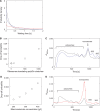Global and local depletion of ternary complex limits translational elongation
- PMID: 20360046
- PMCID: PMC2919707
- DOI: 10.1093/nar/gkq196
Global and local depletion of ternary complex limits translational elongation
Abstract
The translation of genetic information according to the sequence of the mRNA template occurs with high accuracy and fidelity. Critical events in each single step of translation are selection of transfer RNA (tRNA), codon reading and tRNA-regeneration for a new cycle. We developed a model that accurately describes the dynamics of single elongation steps, thus providing a systematic insight into the sensitivity of the mRNA translation rate to dynamic environmental conditions. Alterations in the concentration of the aminoacylated tRNA can transiently stall the ribosomes during translation which results, as suggested by the model, in two outcomes: either stress-induced change in the tRNA availability triggers the premature termination of the translation and ribosomal dissociation, or extensive demand for one tRNA species results in a competition between frameshift to an aberrant open-reading frame and ribosomal drop-off. Using the bacterial Escherichia coli system, we experimentally draw parallels between these two possible mechanisms.
Figures





Similar articles
-
Recognition of the mRNA selenocysteine insertion sequence by the specialized translational elongation factor SELB.Genes Dev. 1994 Feb 1;8(3):376-85. doi: 10.1101/gad.8.3.376. Genes Dev. 1994. PMID: 8314089
-
Dynamic pathways of -1 translational frameshifting.Nature. 2014 Aug 21;512(7514):328-32. doi: 10.1038/nature13428. Epub 2014 Jun 11. Nature. 2014. PMID: 24919156 Free PMC article.
-
Enzymic binding of aminoacyl-tRNA to Escherichia coli ribosomes using modified tRNA species and tRNA fragments.Methods Enzymol. 1979;60:615-28. doi: 10.1016/s0076-6879(79)60058-7. Methods Enzymol. 1979. PMID: 379537 No abstract available.
-
[tRNA-binding centers of Escherichia coli ribosomes and their structural organization].Mol Biol (Mosk). 1984 Sep-Oct;18(5):1194-207. Mol Biol (Mosk). 1984. PMID: 6209546 Review. Russian.
-
Ribosome dynamics during decoding.Philos Trans R Soc Lond B Biol Sci. 2017 Mar 19;372(1716):20160182. doi: 10.1098/rstb.2016.0182. Philos Trans R Soc Lond B Biol Sci. 2017. PMID: 28138068 Free PMC article. Review.
Cited by
-
Conservation of the relative tRNA composition in healthy and cancerous tissues.RNA. 2012 Apr;18(4):640-52. doi: 10.1261/rna.030775.111. Epub 2012 Feb 22. RNA. 2012. PMID: 22357911 Free PMC article.
-
The architecture of eukaryotic translation.Nucleic Acids Res. 2012 Nov 1;40(20):10098-106. doi: 10.1093/nar/gks825. Epub 2012 Sep 10. Nucleic Acids Res. 2012. PMID: 22965119 Free PMC article.
-
Maintenance of tRNA and elongation factors supports T3SS proteins translational elongations in pathogenic bacteria during nutrient starvation.Cell Biosci. 2022 Sep 5;12(1):147. doi: 10.1186/s13578-022-00884-6. Cell Biosci. 2022. PMID: 36064743 Free PMC article.
-
Heterogeneity in HIV and cellular transcription profiles in cell line models of latent and productive infection: implications for HIV latency.Retrovirology. 2019 Nov 11;16(1):32. doi: 10.1186/s12977-019-0494-x. Retrovirology. 2019. PMID: 31711503 Free PMC article.
-
Hyperaccurate Ribosomes for Improved Genetic Code Reprogramming.ACS Synth Biol. 2022 Jun 17;11(6):2193-2201. doi: 10.1021/acssynbio.2c00150. Epub 2022 May 12. ACS Synth Biol. 2022. PMID: 35549158 Free PMC article.
References
-
- Ibba M, Soll D. Aminoacyl-tRNA synthesis. Annu. Rev. Biochem. 2000;69:617–650. - PubMed
-
- Rodnina MV, Wintermeyer W. Ribosome fidelity: tRNA discrimination, proofreading and induced fit. Trends Biochem. Sci. 2001;26:124–130. - PubMed
-
- Dong H, Nilsson L, Kurland CG. Co-variation of tRNA abundance and codon usage in Escherichia coli at different growth rates. J. Mol. Biol. 1996;260:649–663. - PubMed
-
- Ikemura T. Codon usage and tRNA content in unicellular and multicellular organisms. Mol. Biol. Evol. 1985;2:13–34. - PubMed
-
- Zhang G, Hubalewska M, Ignatova Z. Transient ribosomal attenuation coordinates protein synthesis and co-translational folding. Nat. Struct. Mol. Biol. 2009;16:274–280. - PubMed

